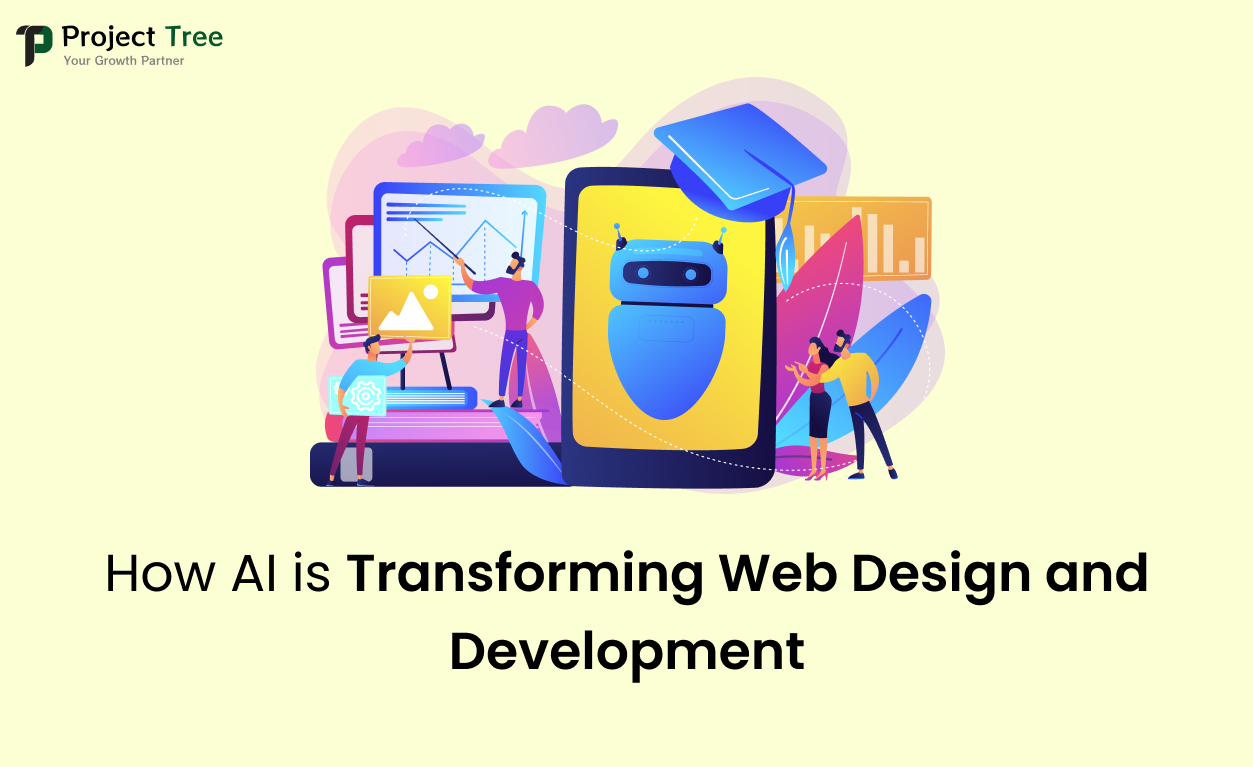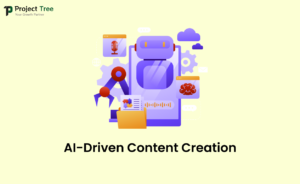Web designing and development is one of the fields where artificial Intelligence (AI) is gradually developing and proving its importance. They range from the basic operational practices of automating processes to improving the aesthetic design that drives engagement of the web users. In light of this, this article seeks to unveil the changes that AI brings in web design and development and does it in a factual and pragmatic manner.
1. AI-Powered Design Tools
AI is also implemented in the web design and development industry in the aspect of AI-powered design tools that have been developed. These tools employ machine learning techniques in order to help designers in the process of designing beautiful and effective websites.
Adobe Sensei is a particularly good illustration. the service is designated as an artificial intelligence, but it is rather a collection of various tools. It is designed to work in association with Adobe’s other design applications to improve design workflows. By using artificial intelligence, Adobe Sensei looks at the user’s preferences and suggests design ideas popular and trending at the moment. This capability helps to complete the designing in less time because it is built to perform repetitive tasks and presents ideas that could be appealing to the target group.
If not for anything, they also enhance the efficiency of the process while increasing the chances that the final designs will capture the user’s favorites, hence enhancing engagement and satisfaction.
2. Enhanced User Experience with AI
Here AI impact does not only stop in design tools but also in improving users’ experiences. The user experience is mastered by the AI algorithm that collects the user’s data to make suitable recommendations on websites. This can include, but is not limited to, using specific content for a specific user, changing the interface for a specific user, and any other content adjustment.
Recommendation engines are a prime example; these are usually applied on e-commerce websites to try to sell products to customers. Platforms such as Amazon and Netflix incorporate AI to consider clients’ activity and offer them products or content that they once interacted with. These systems enhance the utility of the site as it provides tips to the users that can retain their attention and cause purchases.
As part of personalization, another area of AI use is in the chatbots that companies use to communicate with their customers. AI-enabled tools to provide employees or customers with live help, responding to their questions, helping them to complete certain tasks, or providing them with options. A report by Juniper Research holds that by 2025, chatbots will be responsible for about 75% of all customer service interactions. They are fast at responding and enhancing user experience since most questions do not require a live person.
3. Automated Testing and Quality Assurance
AI is also disrupting the web design and development of websites by taking control of testing the website as well as quality assurance. Earlier, it was a laborious process that was time-consuming and used to demand a lot of manual intervention. Modern testing tools leverage AI in that the testing process can be initiated through machine learning that searches for bugs and performance problems.
Selenium and Testim are two of the test automation tools that employ AI. There is a common testing framework called selenium, through which it is also empowered by artificial intelligence. It can synthesize test scripts and also recognize shifts in the UI of the application under test.
On the other hand, Testim utilizes machine learning to develop as well as run them. To track and report on problems, it processes behavioral data of web applications. This approach helps in minimizing the time and effort that are otherwise consumed in manual testing of web-based applications, and hence the quality and reliability of the web applications are achieved.
4. AI-Driven Content Creation
Another field where AI is making standout is content creation. Web content can be created using AI by writing articles, web content, images, and videos.
Copy.ai and Jasper are two tools that help users come up with written content from input provided by the user. These tools employ NLP to develop syntactical, semantically flowing, and relevant text. For instance, a marketing team may employ Copy.AI, which can be used to write blogs and social media content, which can be time-consuming and tiring most of the time.
In the case of artistic content, DeepArt and Runway ML can generate images and videos through the use of artificial intelligence. DeepArt applies painting styles to images, and Runway ML provides numerous AI models for the creation and processing of visual data. These tools help designers develop modern and interesting content without having to invest a lot of time in it.
5. Improving Accessibility with AI
Although accessibility is a fundamental component of the website design, it is still beautiful that AI is pushing web accessibility for the disabled forward. There are such features that AI can parse the Website content and report the deviations from the accessibility guidelines and that AI can offer possible improvements.
WAVE and Axe are web-based accessibility tools that scan websites to check their conformity to accessibility standards. Some of them include omissions of alt tags for images or wrong contrast levels and they propose corrections. The following tools assist developers in designing web sites in such a way that they will be accessible to all people of diverse disabilities, including the visually impaired, the hearing impaired, and the learning disabled.
Other ways AI can improve access are by real-time translation and speech recognition. Google Translate employs the use of Artificial Intelligence to give real-time automatic translation of webpage to various languages so that more people can access them. Likewise, with the help of AI, tools like speech-to-text tools can help in transcribing spoken words into written words, thus helping disabled persons.
6. Data-Driven Web Design Decisions
AI assists developers and uses white space design to make choices based on data by examining huge amounts of data to find insight. These findings may drive design choices, advertising campaigns, and user interface improvements.
Google Analytics and Hotjar are powered by AI devices for monitoring site user activity. Google Analytics is a tool that collects data on the demographics of users, activity, and conversations, while Hotjar uses heatmaps and recording of sessions to illustrate how individuals use websites. These findings enable developers and designers to make better choices regarding arrangement, happiness, and function.
Artificial intelligence also supports A/B testing, which analyzes various versions of a web page to see which one performs better. Machine learning algorithms analyze the results of A/B tests and provide suggestions for improving web pages, boosting conversions, and increasing user engagement.
7. AI in Web Development Automation
There is less need for routine tasks and manual coding as a result of AI automating a lot of web design and development. The GitHub Copilot is powered by AI completion tool that helps developers by suggesting code samples according to the environment. This speeds up the creation process and reduces the risk of errors through providing appropriate code recommendations.
AI in web design and development is also demonstrated by Builder.ai. It offers a structure for optimizing the creation procedure by using AI to produce software according to the requirements of users. This approach reduces the creation procedure and makes it easier to comprehend to users who are not technical.
8. Predictive Analytics and Performance Optimization
AI web design and development enhances web acceleration by anticipating issues before they happen and improving speed using real-time data. Both New Relic and Dynamics are natural intelligence-powered monitoring remedies that evaluate the performance of web applications and identify blockages and possible weaknesses.
These tools employ statistical analysis to predict problems with performance and offer techniques for fixing them. Thus, they can identify possible system overloaded or slow responses and suggest modifications to enhance efficiency. By anticipating difficulties, AI assists in ensuring that sites perform effortlessly and effectively.
9. AI-Enhanced SEO Strategies
Search Engine Optimization (SEO) is essential for securing customers to web pages, and artificial intelligence helps enhance SEO techniques. Ahrefs and SEMrush use machine learning to assess algorithms used by search engines to offer insights into website optimization. These instruments offer keyword suggestions, backlink analysis, and competitor data, helping companies to improve their search rankings.
Artificial intelligence systems also monitor client searches to make suggestions for optimization of content. For instance, AI may identify prevalent subjects and offer suggestions for articles that are expected to draw more viewers. This data-driven strategy allows companies to remain up with SEO developments and improve their online presence.
Conclusion
At Projecttree, AI is revolutionizing web design and development by enhancing user experiences, simplifying procedures, and providing valuable information. AI is transforming the way webpages are developed and preserved, via Intelligence-powered design instruments and tailored client experiences to automated evaluation and material creation. When artificial intelligence technology develops, its effect on web development is likely to get even stronger, providing new chances for creativity and enhancement. Developers and designers can use AI to develop more effective, engaging, and accessible websites that meet the expectations of modern users.
Explore how Project Tree’s innovative development solutions power seamless integration and efficient workflows in healthcare through our collaboration with DrPro, the leading Hospital Management System platform.
FAQs
Q1. How is AI enhancing the web design process?
It empowers web designers with what would otherwise be repetitive tasks such as designing layout, color, and customization of the user experience so that designers can use their talents and time to think creatively.
Q2. What role does AI play in web development?
AI brings improvements in rate in the production of web development by enhancing its code, minimizing the entire time for testing, and making forecasts of users’ actions that lead to more quickly delivered and efficient and, at the same time, user-oriented websites.
Q3. Can AI improve website performance and SEO?
Oh yes, some algorithms scan website data to determine how best to speed up its loading, identify necessary improvements in terms of SEO, and customize the content in order to promote its ranking on search engine result pages.
Q4. Is AI in web design and development accessible to small businesses?
Absolutely. Most of the AI web design and development tools are cheap and easy to use, making it possible for small businesses to build first-rate, efficient, and functional websites without having to acquire a lot of skills in website development.
Q5. What are the challenges of integrating AI into web design and development?
Some of the concerns are privacy and security of data, the courses that AI becomes very hard to understand, and sometimes it hinders creativity because everything is automated.


